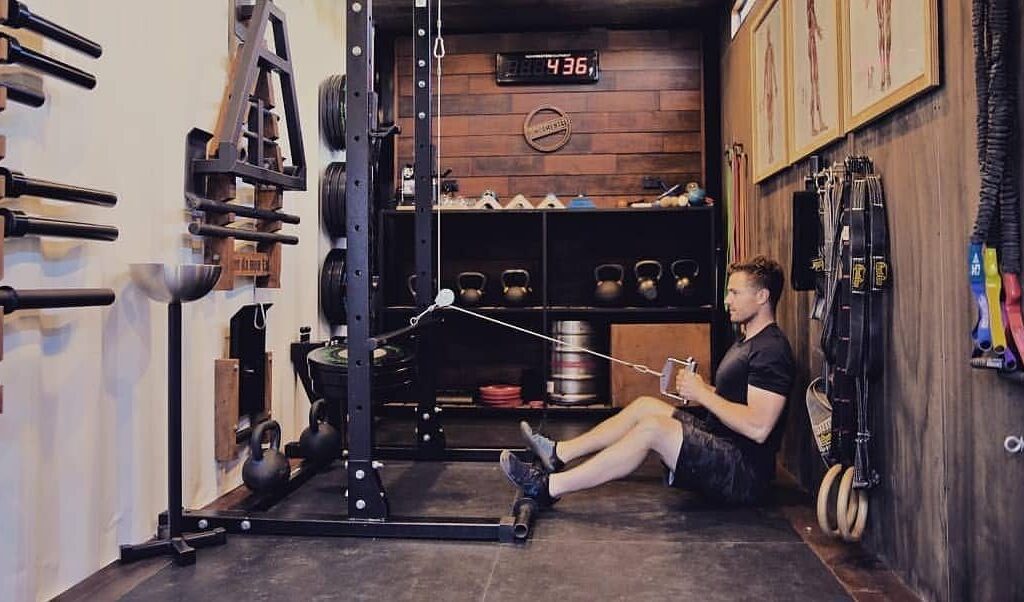Imagine waking up, throwing on your workout clothes, and stepping into your own personal fitness sanctuary – no crowded locker rooms, no waiting for equipment, just pure exercise bliss. That’s the magic of a home gym! But where do you even begin? This comprehensive guide will be your roadmap to crafting the perfect home gym, tailored to your fitness goals and budget.

Finding Your Fitness Oasis: Location, Space Considerations, and Setting the Mood
First things first, location! Ideally, choose a dedicated space in your home that’s free from clutter and has enough room to move around comfortably. A spare bedroom, converted garage, or even a designated area in your basement can all be transformed into your fitness haven. Think about the type of workouts you’ll be doing – will you need ample floor space for yoga or bodyweight exercises, or do you prioritize weight training equipment?
Next, create a motivating atmosphere! Pump up the energy with upbeat music, inspirational quotes on the walls, or even fairy lights for a touch of ambiance. After all, a space you enjoy spending time in is key to sticking with your fitness routine.
Building Your Fitness Arsenal: Essential Equipment for Different Fitness Goals
Now, let’s get down to the nitty-gritty – the equipment! Here’s a breakdown of some essential gear based on common fitness goals:
- Strength Training: The foundation of many home gyms. Consider free weights (dumbbells, barbells, kettlebells), weight plates, a squat rack or power rack for supported exercises, and an adjustable bench for various workouts.
- Cardio: Get your heart pumping with a treadmill, stationary bike, elliptical trainer, or even a jump rope for high-intensity interval training (HIIT).
- Flexibility and Core Workouts: A yoga mat is a must-have for stretching, yoga routines, and bodyweight exercises. Resistance bands can add variety and challenge to your workouts, while a stability ball can improve core strength and balance.
Remember, this is just a starting point! Consider your budget and prioritize equipment that aligns with your specific goals.
Safety First: Essential Tips and Considerations for a Home Gym
Safety is paramount! Here are some crucial tips to keep in mind:
- Rubber Flooring: Invest in rubber floor mats to protect your floor from dropped weights and provide cushioning for exercises.
- Proper Form is Key: Especially when lifting weights, proper form is essential to prevent injury. Consider consulting a personal trainer for guidance or utilize online resources to learn proper exercise technique.
- Listen to Your Body: Don’t push yourself too hard, and take rest days when needed.
- First-Aid Kit: Be prepared for minor bumps and bruises by having a well-stocked first-aid kit on hand.

By prioritizing safety, you can ensure your home gym remains a place of healthy progress, not injury.
Beyond the Basics: Enhancing Your Home Gym Experience
Once you have the essentials, consider these upgrades to elevate your home gym experience:
- Mirrors: They help you monitor your form and create a more spacious feel.
- Pull-up Bar: A doorway pull-up bar is a space-saving way to build upper body strength.
- Storage Solutions: Keep your equipment organized and clutter-free with shelves, racks, or storage containers.
- Technology Integration: Consider a fitness tracker, a smart TV for workout videos, or even a fitness mirror with interactive workout programs.
These additions can personalize your home gym and make your workouts more engaging.
Fueling Your Fitness Journey: Nutrition for Home Gym Success
Remember, exercise is just one piece of the fitness puzzle! Nutrition plays a vital role in supporting your workouts and overall health. Here are some tips:
- Balanced Diet: Focus on whole, unprocessed foods like fruits, vegetables, lean protein sources, and whole grains.
- Hydration is Key: Drink plenty of water before, during, and after your workouts to stay hydrated and support muscle recovery.
- Post-Workout Nutrition: Refuel your body with a combination of protein and carbohydrates after your workout to aid muscle repair and growth.
By taking care of your nutrition, you’ll maximize the benefits of your home gym workouts.
Staying Motivated: Creating a Sustainable Home Gym Routine
So, you’ve built your dream home gym – now what? Here are some tips to stay motivated and make your workouts a consistent habit:
- Set SMART Goals: Specific, Measurable, Achievable, Relevant, and Time-Bound goals will keep you focused and provide a sense of accomplishment.
- Find a Workout Buddy: Having a friend or family member to train with can boost accountability, add a social element, and make workouts more fun.
- Schedule Your Workouts: Treat your home gym sessions like important appointments. Block out time in your calendar and stick to your schedule as much as possible.
- Variety is Key: Don’t get stuck in a rut! Try different workout routines, explore new exercises, and challenge yourself with progressive overload (gradually increasing weight, sets, or reps) to keep things interesting.
- Track Your Progress: Seeing your improvement is a powerful motivator! Keep a workout journal, track your weightlifting progress, or use a fitness app to monitor your performance.
- Reward Yourself: Celebrate your milestones! Treat yourself to a new piece of workout gear, a relaxing massage, or anything that motivates you to keep pushing forward.
By incorporating these strategies, you can transform your home gym into a launchpad for sustainable fitness success.
Home Gym Myths Debunked: Building Without Breaking the Bank
There are some common misconceptions about home gyms. Let’s debunk a few myths:
- Myth #1: Home Gyms are Expensive: You can build a fantastic home gym on a budget! Start with essential equipment and gradually add pieces over time. Utilize used equipment websites, garage sales, or even explore bodyweight exercises that require minimal equipment.
- Myth #2: Home Gyms Require a Lot of Space: Even a small corner of your home can be transformed into a functional workout space. Consider space-saving equipment, creative organization solutions, and bodyweight exercises that require minimal square footage.
- Myth #3: Home Gyms are Isolating: While you won’t have the social interaction of a traditional gym, you can stay connected with online fitness communities or find workout buddies to train with virtually.
By understanding these myths, you can approach building your home gym with a more realistic and achievable mindset.

The Future of Fitness is Here: Embrace the Convenience and Freedom of Your Home Gym
The rise of home gyms signifies a shift towards a more personalized and convenient approach to fitness. With dedication, planning, and the right equipment, you can create a home gym that caters to your unique goals and preferences. So, ditch the gym membership fees, ditch the crowded locker rooms, and embrace the freedom and flexibility of your own personal fitness sanctuary. Remember, the most effective gym is the one you’ll actually use, and a home gym puts the power of fitness right at your fingertips.
Read Also
- “Perfection” by R.L. Mathewson.
- The Ultimate Guide to Learning a New Language
- “The Law of Attraction” by N.M. Silber
- “The Proposition” by Katie Ashley
FAQs
1. What if I live in a small apartment and don’t have a lot of space?
No problem! You can still build a functional home gym even with limited space. Focus on bodyweight exercises, resistance bands, and space-saving equipment like a doorway pull-up bar or an adjustable kettlebell. Utilize online workout routines designed for small spaces to maximize your workouts.
2. I’m a complete beginner. Where do I even start?
Start with the basics! Invest in a yoga mat, a set of light dumbbells, and some resistance bands. You can find countless free beginner-friendly workout routines online or on fitness apps. Consider consulting a certified personal trainer for a few initial sessions to learn proper form and create a safe and effective workout plan.
3. How can I stay motivated in the long run?
Variety is key! Explore different workout styles, find workout buddies online or in your community, and track your progress to celebrate your achievements. Reward yourself for reaching milestones, and remember, consistency is more important than intensity. Even short, daily workouts are more effective than sporadic bursts of intense training.
4. Is a home gym really cheaper than a gym membership?
In the long run, a home gym can be more cost-effective, especially if you factor in the cost of commuting to and from a gym. However, it depends on your budget and workout style. If you prefer group fitness classes or require specialized equipment you won’t use often, a gym membership might be a better option.

